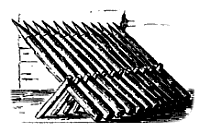 Also called Spanish
Riders.* A Cheval-de-frise was a non-static
obstacle consisting of a horizontal beam 9 to 12 feet long and 1 foot in
diameter pierced by two diagonal rows of sharpened lances which were about
2 inches in diameter and 10 feet long. Eye bolts or hooks and chains were
attached to the ends of the beams to allow several cheval-de-frise to be
bound together to form a chevaux-de-frise. Since this type of obstacle was
free standing and could be moved about it was considered suitable for blocking
roadways and closing the entrances to temporary fortifications. Most sources
insist that chevaux-de-frise were also useful against cavalry, though situations
in which this type of obstacle could be employed in a practical fashion solely
against cavalry attack are not generally described. Chevaux-de-frise were
often employed to cover the fronts of works exposed to enemy fire when the
danger posed by Also called Spanish
Riders.* A Cheval-de-frise was a non-static
obstacle consisting of a horizontal beam 9 to 12 feet long and 1 foot in
diameter pierced by two diagonal rows of sharpened lances which were about
2 inches in diameter and 10 feet long. Eye bolts or hooks and chains were
attached to the ends of the beams to allow several cheval-de-frise to be
bound together to form a chevaux-de-frise. Since this type of obstacle was
free standing and could be moved about it was considered suitable for blocking
roadways and closing the entrances to temporary fortifications. Most sources
insist that chevaux-de-frise were also useful against cavalry, though situations
in which this type of obstacle could be employed in a practical fashion solely
against cavalry attack are not generally described. Chevaux-de-frise were
often employed to cover the fronts of works exposed to enemy fire when the
danger posed by
 prolonged exposure to hostile fire, even during the night, was
too great to permit working parties to construct more solidly fixed obstacles.
Chevaux-de-frise could also be applied to the bottom of ditches to inhibit
an attacking body of troops' free circulation through the ditch, though in
this situation each cheval-de-frise could be moved about by the attacking
troops and used to assist them in scaling the scarp. prolonged exposure to hostile fire, even during the night, was
too great to permit working parties to construct more solidly fixed obstacles.
Chevaux-de-frise could also be applied to the bottom of ditches to inhibit
an attacking body of troops' free circulation through the ditch, though in
this situation each cheval-de-frise could be moved about by the attacking
troops and used to assist them in scaling the scarp.
 A second type of cheval-de-frise described by some
sources was constructed using a stout sharpened timber or palisade to which
one or more legs were attached to fix it in an upright position inclined
toward the direction of an expected attack. This type of obstacle would have,
when a number of cheval-de-frise were positioned close together, created
the effect of a sort of movable inclined palisading. Unless these cheval-de-frise
were tied together by means of a horizontal beam it seems doubtful whether
their lateral stability would be sufficient to prevent attacking troops from
simply knocking them over onto the ground rather than being compelled to
chop their way through the obstacle with axes. A second type of cheval-de-frise described by some
sources was constructed using a stout sharpened timber or palisade to which
one or more legs were attached to fix it in an upright position inclined
toward the direction of an expected attack. This type of obstacle would have,
when a number of cheval-de-frise were positioned close together, created
the effect of a sort of movable inclined palisading. Unless these cheval-de-frise
were tied together by means of a horizontal beam it seems doubtful whether
their lateral stability would be sufficient to prevent attacking troops from
simply knocking them over onto the ground rather than being compelled to
chop their way through the obstacle with axes. |